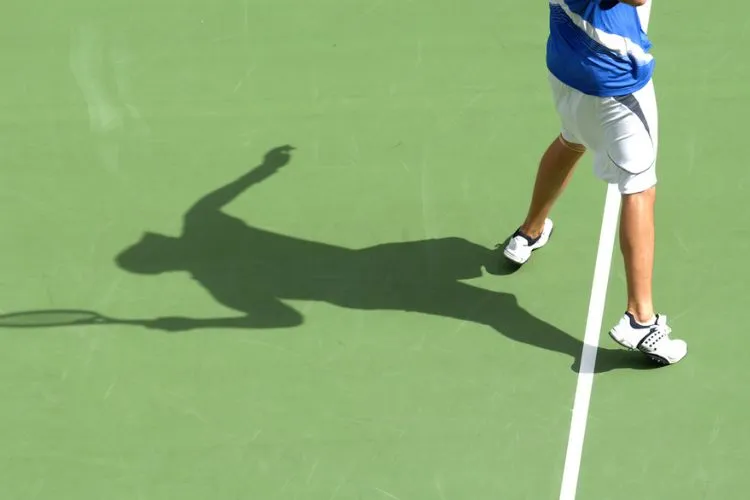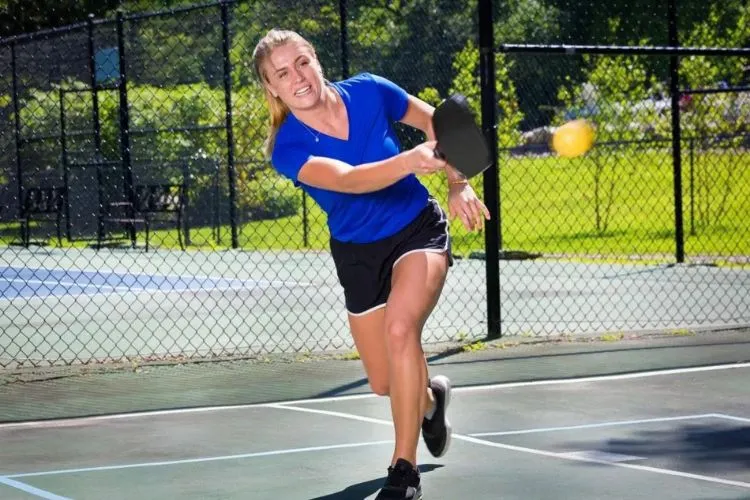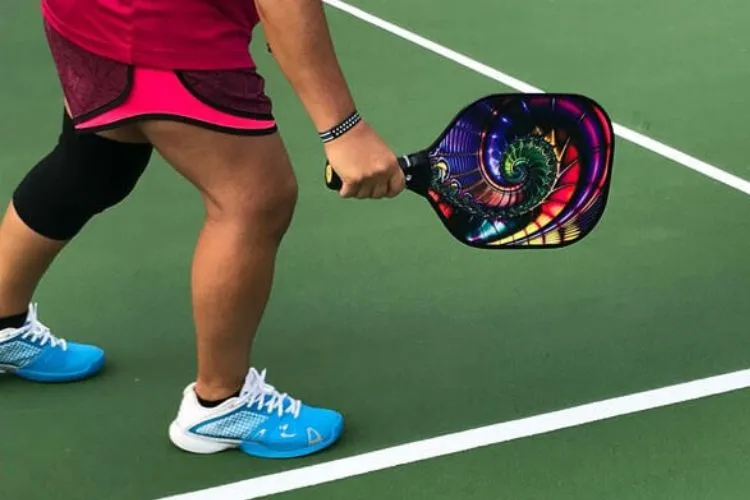Pickleball has gained immense popularity in recent years, attracting players of all ages and skill levels. This fast-paced sport combines elements of tennis, badminton, and table tennis.
As with any sport, mastering the rules and techniques is crucial to improving your game. One important aspect that players often overlook is foot faults in pickleball. So, what is a foot fault in pickleball?

A foot fault occurs when a player steps into a restricted area or violates certain rules while executing a shot.
This comprehensive guide will explain what foot faults are, explore their types, and offer tips to avoid them on the court.
What is a Foot Fault in Pickleball?
A foot fault in pickleball is defined as an infringement of the rules regarding player positioning on the court during a shot. It can occur at two different times in a pickleball game: during the serve and when playing around the non-volley zone (NVZ) or kitchen.
Service Foot Faults
Service foot faults occur when a player fails to follow the proper serving technique or violates service rules. The key elements of service foot faults include the server’s feet position, their positioning on the court, and their contact with the service boundary lines.
Understanding Service Foot Faults
To prevent service foot faults, players must understand the rules and regulations surrounding the pickleball serve. According to the official rulebook, the server must have both feet behind the baseline and within the service area. Failure to meet these criteria constitutes a foot fault.
Common Reasons Leading to Service Foot Faults
Several factors contribute to service foot faults. Improper alignment, where the server’s feet cross or step on the baseline, is a common mistake. Additionally, stepping on or over the sideline before contacting the ball is also considered a foot fault.

In addition to improper alignment and stepping on or over the sideline, there are a few more common reasons that can lead to service foot faults in pickleball. These reasons include:
- Foot Placement: One common mistake is when the server’s feet are not aligned properly. This can happen when one foot is in front of the other or when the feet are too wide or too close together. It is important to have both feet parallel to each other and within the service area to avoid foot faults.
- Lack of Awareness: Sometimes, players may not pay close attention to their foot placement during the serve. This can lead to inadvertently stepping on or crossing the baseline, resulting in a foot fault. It is essential to maintain focus and be aware of your positioning on the court to avoid foot faults.
- Foot Positioning during the Toss: The placement and movement of the feet during the toss can also contribute to foot faults. If the server’s feet move forward or backward during the toss, it can lead to a foot fault. It is crucial to keep the feet in a stable position during the toss and throughout the serve.
- Lack of Practice: Inexperience or lack of practice can also contribute to foot faults. Serving in pickleball requires muscle memory and consistency in footwork. Regularly practicing the serve can help players develop the right technique and footwork, reducing the risk of foot faults on the court.
- Nervousness or Pressure: When players are nervous or under pressure, they may lose focus on their foot placement. Anxiety can lead to unintentional foot faults, so it is important to remain calm and composed during the serve to avoid these mistakes.
By paying attention to these common reasons and practicing proper footwork, players can minimize the occurrence of foot faults during the service in pickleball.
Tips to Avoid Service Foot Faults
- Proper Positioning and Alignment: Maintaining the correct position during the serve is crucial to avoid foot faults. Ensure that both feet are behind the baseline, parallel to each other, and within the service area. Practicing the proper stance and alignment will help develop muscle memory and reduce foot fault occurrences.
- Footwork Techniques: Pay attention to your footwork during the serve. Simple techniques, like the sideways shuffle or the pivot technique, can improve your balance and eliminate the risk of foot faults. Practice these footwork techniques to develop a consistent and accurate serve.
- Practicing Correct Serving Technique: A smooth and controlled serve is essential to minimize the chances of foot faults. Focus on your technique, including your grip, stance, and swing motion. Practicing correct serving technique regularly will help you maintain balance and prevent foot faults during competitive play.
Non-Volley Zone Foot Faults
Non-volley zone foot faults occur when players enter the non-volley zone while executing a shot. The non-volley zone, also known as the kitchen, is a marked area on the pickleball court that restricts players from hitting the ball out of the air within its boundaries.

Explaining Non-Volley Zone Foot Faults
To understand non-volley zone foot faults, players must be aware of the rules regarding the non-volley zone. The non-volley zone extends 7 feet from the net on each side and is marked with a solid line. According to the rules, players are forbidden from entering this zone and hitting the ball before it bounces.
Causes of Non-Volley Zone Foot Faults
There are several common causes that lead to non-volley zone foot faults. Being impatient and trying to hit the ball from a position inside the non-volley zone is a frequent mistake. Additionally, overly aggressive shots that require players to move forward quickly often result in foot faults.
In addition to being impatient and overly aggressive, there are a few more common causes that can lead to non-volley zone foot faults in pickleball. These causes include:
- Lack of Awareness: Many players may not have a clear understanding of the boundaries of the non-volley zone. They may inadvertently step into the zone while attempting to hit a shot. It is crucial to be aware of the non-volley zone boundaries and make a conscious effort to stay outside of it during play.
- Poor Timing and Positioning: Sometimes, players may misjudge the timing and positioning required to execute a non-volley zone shot. They may rush forward too quickly and fail to get their feet outside of the non-volley zone before hitting the ball. This can result in a foot fault.
- Overreaching: When attempting to hit a shot close to the net from outside the non-volley zone, players may unintentionally step into the zone to reach the ball. It is important to avoid overreaching and to maintain balance and control over footwork to prevent foot faults.
- Lack of Footwork Skills: Insufficient footwork skills can also contribute to non-volley zone foot faults. Players may struggle with quick lateral movements, leading to foot faults when attempting to hit shots close to the net. Regular practice of footwork drills can help improve agility and prevent foot faults in the non-volley zone.
- Distractions and Pressure: In competitive play, distractions and pressure can lead to foot faults in the non-volley zone. External factors, such as noise from the crowd or pressure from the opponent, can cause players to lose focus on their foot positioning. It is important to stay focused and mentally prepared during play to avoid foot faults.
By addressing these common causes and practicing proper footwork techniques, players can reduce the occurrence of foot faults in the non-volley zone and improve their overall performance on the pickleball court.
Strategies to Prevent Non-Volley Zone Foot Faults

- Footwork Drills and Exercises: Improving your footwork is crucial to avoiding non-volley zone foot faults. Incorporate footwork drills and exercises into your practice routine. Focus on quick lateral movements and maintaining balance while keeping your feet outside the non-volley zone.
- Maintaining Balance and Control: When approaching the non-volley zone, it is important to maintain balance and control over your movements. Avoid rushing shots and ensure that both feet are outside the non-volley zone before hitting the ball. Staying balanced will reduce the risk of foot faults and enable you to execute shots with precision.
- Understanding Court Positioning: Knowing where to position yourself on the court is essential to avoid foot faults. Stay aware of the court markings and the position of the non-volley zone. By positioning yourself correctly on the court, you can prevent foot faults and maximize your shot selection during the game.
Enforcing Foot Faults during Recreational Play
During casual games, the enforcement of foot faults varies depending on the players’ agreement and the level of competition. In most recreational games, players rely on self-enforcement and typically call their own foot faults.
However, if disputes arise, it is important to communicate openly and resolve disagreements amicably.
You May Also Find Useful: What Is A Non Volley Zone In Pickleball? | What is a Fault in Pickleball?
Frequently Asked Questions (FAQs)
Can foot faults be called during competitive play?
Yes, foot faults can and should be called during competitive play by players, as well as line judges or referees if present.
Can foot faults lead to penalties or loss of points?
Foot faults are considered a violation of the rules and can result in penalties or loss of points, depending on the level of play and the specific tournament or competition rules.
How can I improve my footwork to avoid foot faults?
Practicing specific footwork drills and exercises will help improve your footwork. Focus on lateral movements, balance, and maintaining proper court positioning.
What are some common misconceptions about foot faults in pickleball?
One common misconception is that foot faults only occur during the serve. Foot faults can also happen when players breach the non-volley zone rule.
Is there specific foot fault etiquette to follow in pickleball?
While there may not be a formal foot fault etiquette, it is important to be responsible and honest in calling foot faults during play. Players should communicate respectfully and resolve disputes through open discussion.
Conclusion:
Understanding foot faults is essential for every pickleball player who wants to improve their game. By being mindful of service foot faults and non-volley zone foot faults, players can enhance their court positioning, accuracy, and overall performance.
Remember to focus on proper alignment, footwork techniques, and practicing consistent serving to minimize foot fault occurrences.
By adhering to the rules and implementing the tips provided, players can play pickleball more confidently, minimize mistakes, and enjoy the game to its fullest potential.

Pickleball’s more than a game to me—it’s a passion. I write, sharing its highs and lows, the thrills and the lessons. Some tales might draw you to the court, while others give a hint of the game’s magic. So, curious about my journey? Ready to dive deep into the world of pickleball with me? Let’s go.
